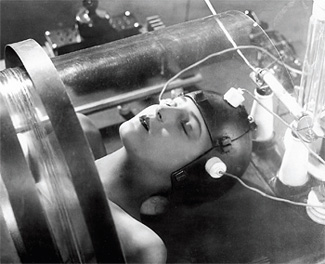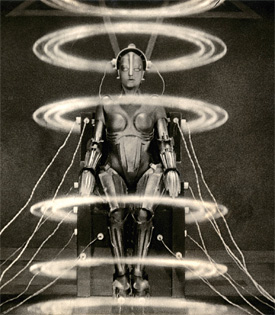'Metropolis' Arises

Only the rising of Atlantis would be as unexpected as discovering a complete version of the film "Metropolis," a classic of special effects and post-production wizardry and the most expensive production of the European silent era.
Often referred to as epitomizing the height of German expressionism, "Metropolis" has inspired a wealth of other cinematic fantasies ranging from 1931's "Frankenstein" to the original Apple Macintosh commercial of 1984.
But for years "Metropolis" has been a battered hero, suffering indignities from distributors' re-cuts ever since its Berlin premiere on Jan. 10, 1927. Originally running an estimated 153 minutes it was re-edited to 90 minutes of incomprehensibility for its U. S. premiere by Paramount in 1928.
Now, however, thanks to an unbelievable fluke of cinematic archeology and the Olympian efforts of the F. W. Murnau Foundation, "Metropolis" has been restored to as close to its original conception as anyone could expect.

Brigitte Helm as Maria. Photos © Stiftung Deutsche Kinemathek - Horst von Harbou It cost more than $840,000 to give it wings, but this new Phoenix took flight again in Europe on Feb. 12, 2010, as part of the 60th Berlin Film Festival, and domestically on April 25 at Grauman's Chinese Theater.
Finally, a Blu-ray and DVD of the complete restoration was released by Kino International on Nov. 16.
Now we can experience the whole story of this dystopian vision of a future society divided into workers and rulers and see the way director Fritz Lang intended it to be edited.
One reason the dream of recapturing "Metropolis" has persisted throughout cinematic history is that understanding its plot is secondary to appreciating its visual glory.
THE PLOT
Very briefly, director Fritz Lang based "Metropolis" on Thea von Harbou's 1926 novella about a city in the distant future where the workers toil on gigantic, dehumanizing machines in massive underground caverns while the owners of the city and their families bask is sun-filled leisure on the surface.
The Master of Metropolis, Joh Fredersen, has tried to protect his son, Freder, from learning the realities of this world he is being bred to inherit. But when Freder ventures into the depths and learns the truth, he is challenged by an angelic vision of hope, Maria, to unite the workers (the "Hands") and the owners (the "Mind") through a mediator (the "Heart").
Concerned the workers are going to rise up against him, Fredersen turns to Rotwang, the mad genius who actually built the city, to give his latest invention—a new robot, or "Machine Man"—the visage of Maria so he can use it to incite the workers to revolt. Then Fredersen can crush the revolution and return the workers to their "rightful place" buried beneath the giant city.
You could call the plot at best a parable, at worst a vision of capitalism gone mad. But there is no doubt, the images of towering skyscapes, soaring Ziggurat buildings and titanic underground machines will stay permanently affixed in the viewer's mind.
In an era before traveling mattes and bluescreen effects, many of the unforgettable images were created using a process developed by Eugen Schüfftan through which angled mirrors were used to insert live actors into miniature sets. The Schüfftan Process was still being used by Peter Jackson in his 2003 film "The Lord of the Rings: The Return of the King."

Brigitte Helm as the robot. Photos © Stiftung Deutsche Kinemathek - Horst von HarbouLOST FOOTAGE
After "Metropolis" lost its U. S. copyright in 1953, anyone could sell duplicates of the surviving chopped up versions and almost everyone did, including Georgio Moroder (think "Flashdance") who released a non-digital restoration with rock soundtrack in 1984. The CD became a classic, but the Moroder version of "Metropolis" is no longer available.
Finally, the F. W. Murnau Foundation released a partially restored digital version in 2002 with the original orchestral score by Gottfried Huppertz. But regrettably, more than 25 minutes of its lost story had to be filled in with stills and explanatory intertitles.
By then, most thought every possible source for a complete version of "Metropolis" had been exhausted. That's why it is so miraculous that in the summer of 2008 Fernando Peña, curator of the Buenos Aires Museo del Cine, discovered cans of 16mm film containing the lost footage. Although stories vary, it may be this was a pirated (or perhaps "protection") dupe of an original release negative that had been flown to Argentine audiences shortly after the film's Berlin premier.
While many of the resurrected scenes are marred with scratches and don't fit the full silent-film aperture, this treasured find became the blueprint for the almost complete version of "Metropolis" Kino brought onto disk this winter. Finally, we can appreciate Lang's original editing and plot structure.
Discovering a complete version of this classic has been one of the most unexpected discoveries of the year now ending.
Jay Ankeney is a freelance editor and post-production consultant in Los Angeles. E-mail him at JayAnkeney@mac.com.
Get the TV Tech Newsletter
The professional video industry's #1 source for news, trends and product and tech information. Sign up below.
